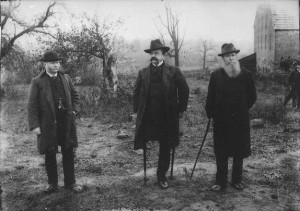Daniel E. Sickles, Concluded
This article is the conclusion of my series on Union Major General Daniel E. Sickles during the Civil War. Before you read this one, you should go read the first and second installments to get the full story.
After Gettysburg, Dan Sickles’ career as a field commander was over. His missing right leg (and his utter lack of qualifications in the first place) assured that. He spent the rest of his Army career as a high-profile recruiter, and as a commander in a few of the departments that the military set up after the war to oversee Reconstruction. He was also involved in some covert diplomacy to ensure that the government of what is now Panama (in the era before we built the canal) would continue to allow our troops to cross their territory on the way to ships waiting in the Pacific.
By 1867, both his daughter, Laura and his wife, Teresa had died from disease. With nothing holding him in the U.S., Sickles took a post as the U.S. Ambassador to Spain during President Grant’s administration. It turns out that he did not have the temperament for diplomacy (I’m sure you’re surprised by that revelation). He did, however continue his womanizing in Europe (reportedly even having an affair with Queen Isabella II) and eventually married Carmina Creagh, the daughter of a Spanish government official.
Returning to the U.S., he served in a few local government roles in New York, most notably as the Chairman of the New York Monuments Commission – the organization that coordinated the funding and dedication of Civil War monuments for the state of New York. This kept him involved in veterans affairs and in Gettysburg, as a large number of monuments were placed there from New Yorkers. His involvement ended when an investigation found that over $25,000 (well over $600,000 in today’s dollars) had gone missing from the commission’s funds. Sickles was forced out on suspicion of embezzlement.

One of the victims of the missing money was a monument to the Excelsior Brigade that was placed at Gettysburg. The loss of funds had left the monument missing one of the elements from its original design: appropriately, that was a bust of General Sickles.
He was re-elected to Congress in 1893 and his most notable contribution from his last term in office was sponsoring the bill that created the Gettysburg National Military Park. He helped to secure the purchase of land around Gettysburg that would become part of the park, and even found a fence to put around the National Cemetery (it was the fence that had been around Lafayette Park, where Sickles had shot Philip Barton Key years before). When asked by a reporter on a tour of the battlefield why there was no individual monument to him, like there was to all the other Corps commanders, Sickles supposedly replied with something to the effect of, “the whole place is a monument to Dan Sickles!” As we’ve seen, modesty was not his strong suit.

Adding to his mystique, Sickles was later awarded the Medal of Honor for his actions at Gettysburg. The citation read:
“Displayed most conspicuous gallantry on the field vigorously contesting the advance of the enemy and continuing to encourage his troops after being himself severely wounded.”
Not to speak ill of the man, but this is just a little exaggerated, right? Especially that part about “encouraging his troops” that was probably inspired by the cigar-smoking legend I referenced earlier. You also have to remember that the Medal of Honor was newly-created for the Civil War and there were no lesser medals (Bronze Star, Silver Star, etc.) at the time, so you were either awarded the Medal of Honor or nothing (although as an officer, you could also be given a purely-honorary promotion called a “brevet“). Just to give you an idea of how loose the qualifications were in those days, there were scores of men who were awarded the Medal of Honor for picking up flags that had been dropped by the enemy.
Sickles died in 1914 at the age of 94 in New York. His funeral was held in New York City, and he was buried according to his wishes in Arlington National Cemetery, a controversial and fascinating character to the end.
Also – If you’re interested in learning more about Dan Sickles, may I suggest James Hessler’s outstanding book, Sickles at Gettysburg? While it focuses specifically on his involvement with Gettysburg (both during and after the war) it gives a good overview of his life in the process.